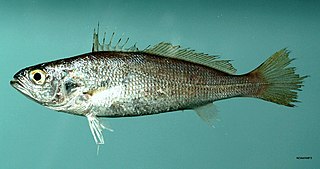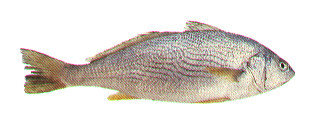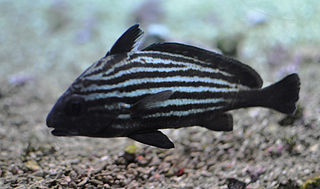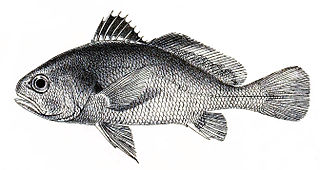
Cynoscion regalis, the weakfish, is a marine ray-finned fish of the family Sciaenidae, the drums and croakers.

Sciaenidae is a family of ray-finned fishes belonging to the order Acanthuriformes. They are commonly called drums or croakers in reference to the repetitive throbbing or drumming sounds they make. The family consists of about 293 to 298 species in about 66 or 67 genera.

Spotted seatrout, also known as speckled trout, is a common estuarine fish found in the southern United States along coasts of Gulf of Mexico and the coastal Atlantic Ocean from Maryland to Florida. While most of these fish are caught on shallow, grassy flats, spotted seatrout reside in virtually any inshore waters, from the surf of outside islands to far up coastal rivers, where they often come for shelter during cold weather. Contrary to its name, the spotted seatrout is not a member of the trout family (Salmonidae), but of the drum family (Sciaenidae). It is popular for commercial and especially recreational fishing in coastal waters of the southeastern United States. Adults reach 19–37 inches in length and 3–17 pounds in weight.

Cynoscion acoupa, the acoupa weakfish, blacktail basher or grey snapper, is a species of marine ray-finned fish belonging to the family Sciaenidae, the drums and croakers. This fish is found in the western Atlantic.

Micropogonias is a genus of marine ray-finned fishes belonging to the family Sciaenidae, the drums and croakers. These fishes are found in the eastern Pacific and western Atlantic Oceans.

The Atlantic croaker is a species of marine ray-finned fish belonging to the family Sciaenidae and is closely related to the black drum, the silver perch, the spot croaker, the red drum, the spotted seatrout, and the weakfish. It is commonly found in sounds and estuaries from Massachusetts to the Gulf of Mexico.

Cilus is a monospecific genus of marine ray-finned fish belonging to the family Sciaenidae, the croakers and drums. Its only species is Cilus gilberti, the corvina or corvina drum, which is found mostly tropical to temperate coastal waters of the southeastern Pacific along Central and South America. The corvina is highly prized in South America as a food fish.

Cynoscion arenarius, sand seatrout, sand weakfish or white trout, is a species of marine ray-finned fish belonging to the family Sciaenidae, the drums and croakers. It is found in the western Atlantic Ocean. It is closely related to the common weakfish and may be a subspecies of C. regalis.

Nebris is a small genus of marine ray-finned fishes belonging to the family Sciaenidae, the drums and croakers. There are two species in the genus, one in the Western Atlantic Ocean and one in the Eastern Pacific Ocean.

Umbrina is a genus of fish from the croaker family Sciaenidae. The genus contains 17 species occurring in tropical and warm temperate waters of the Atlantic, the Mediterranean, the Western Indian Ocean and the eastern Pacific.

Atractoscion is a genus of marine ray-finned fished belonging to the family Sciaenidae, the drums and croakers. The fishes in this genus are found in the Atlantic, Indian and Pacific Oceans.

Pareques is a genus of marine ray-finned fishes belonging to the family Sciaenidae, the drums and croakers. These fishes are found in the western Atlantic Ocean and eastern Pacific Ocean.

The silver seatrout, also known as white trout, sugar trout, and silver weakfish, is a species of marine ray-finned fish belonging to the family Sciaenidae, the drums and croakers. This fish is found in the Western Atlantic Ocean.

Odontoscion dentex, the reef croaker or brown large-eyed croaker, is a species of marine ray-finned fish belonging to the family Sciaenidae, the drums and croakers. It is found in coral and rocky reefs of the tropical Western Atlantic, living as solitary individuals or in small groups at a depth of 1 to 30 m. This species feeds on small fish, shrimp, and larvae.

The geelbeck croaker, also known as the African weakfish or Cape salmon, is a species of marine ray-finned fish belonging to the family Sciaenidae, the drums and croakers. This species is found in the southwestern Indian Ocean off southeastern Africa.

Isopisthus is a genus of marine ray-finned fishes belonging to the family Sciaenidae, the drums and croakers. These fishes are found in the western Atlantic and eastern Pacific Oceans.

Johnius dussumieri, the sin croaker, Dussumier's croaker, Dussumier's silver jewfish, sharptooth hammer croaker or whiskered croaker, is a marine ray-finned fish belonging to the family Sciaenidae, the drums and croakers. This fish is found in the Indian Ocean.

The kathala croaker is a species of marine ray-finned fish belonging to the family Sciaenidae, the drums and croakers. This species is found in the Indian Ocean off South Asia. It is the only species in the monospecific genus Kathala.

Macrodon is a genus of marine ray-finned fishes belonging to the family Sciaenidae, the drums and croakers. These fishes are found in the eastern Pacific and western Atlantic Oceans.

Odontoscion is a genus of marine ray-finned fish belonging to the family Sciaenidae, the croakers and drums. These fishes are found in the Western Atlantic and Eastern Pacific Oceans.

















